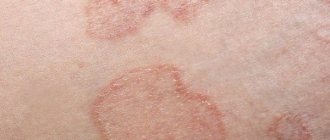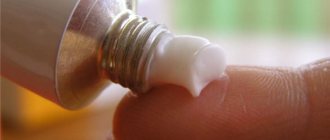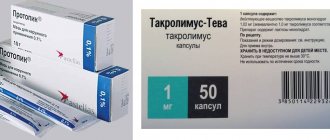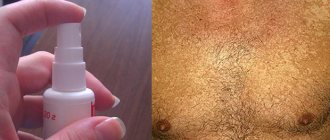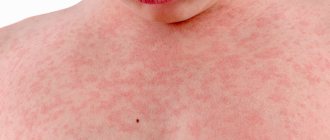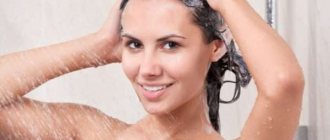Ringworm (dermatomycosis, microsporia, trichophytosis, scab) is a fairly ancient disease.
Descriptions of this disease exist in the works of the ancient Roman doctors Cornelius Celsus and Cassius Felix. The cause of the disease is fungal microspores.
They land on the surface of the skin or hair and begin to multiply quickly. The skin becomes covered with ulcers that itch unbearably, and bald spots appear on the head.
What is lichen, symptoms, diagnosis
Ringworm is a fungal type disease that spreads to the skin. Characteristic signs are the appearance of peculiar spots on the body, which are accompanied by slight itching and peeling of skin particles.
According to statistics, this disease affects people aged 30 to 70 years , as well as children. Moreover, men and women are equally susceptible to it.
The main cause of the disease is fungal (viral) microflora . The structure of the lesion is unknown, because not all people, even those at risk, are affected by this disease. It is assumed that a combination of many factors may be precursors to this disease.
- Being under constant stress.
- Weakened immunity.
- Defeat by infections.
- Genetic predisposition.
- Physical exercise.
- Emotional stress.
How does the disease manifest itself?
Ringworm begins in the form of a rash with slight itching. Small red or brown spots appear first. The plaques gradually increase in size and merge with each other, forming large affected areas.
The pathogen produces azelaic acid, the action of which causes cells to stop producing the pigment that colors the skin when exposed to the sun.
As a result, infected areas of the epithelium do not change color when tanning. Because of this clinical picture, the disease resembles the skin disease vitiligo. Usually the spots are localized in the neck, chest, back, and abdomen.
Important!
To establish a diagnosis and appropriate treatment, you need to consult a dermatologist.
An unpleasant symptom of tinea versicolor is itching . The fungus loosens the outer layer of the skin, forming scales that look like bran. The affected areas begin to peel off.
Symptoms
The emerging lichen is determined by distinct and pronounced signs. But to establish the correct diagnosis, tests are necessary.
However, there are common signs that cannot be confused with other diseases:
- The appearance of pink (milky) spots on the skin.
- Peeling is observed along the edges.
- There is pronounced redness in the center.
- Itching sensation.
What folk remedies help in treating the disease?
The most famous method is using apple cider vinegar. They lubricate the affected areas of the skin. This needs to be done three times daily. Celandine helps a lot. A tincture is prepared from it. Flowers and leaves are poured into an opaque and dark bowl and filled with vodka so that it completely covers them. Then the container is tightly closed, shaken well and left for several weeks. You can take it not only during treatment, but also for prevention - 2 times a day. 15 drops of infusion are diluted with water. The maternal plaque is simply wiped several times daily.
A tincture is also prepared from elder flowers. To do this, take one tablespoon of herb and pour a glass of boiling water. Let it infuse for half an hour and take four tablespoons 3 times a day.
Diagnostics
Despite the fact that the disease has characteristic symptoms, a diagnosis cannot be made based on appearance alone.
For a more accurate determination, it is necessary to conduct detailed tests and take skin scrapings from the affected area. Only based on the results obtained, it is possible to establish a specific type of disease and prescribe treatment specific to this type.
It is simply impossible to establish an accurate diagnosis based only on the appearance of the spot.
Types of lichen
Depending on the age and gender of the patient, the types of disease may vary, but general data about the disease may be almost the same. The duration of the disease and the nature of its course can also be varied: from acute to chronic.
According to medical data, there are 4 types of the disease:
Shearer
This disease is quite often recorded in children. It is transmitted mainly from sick animals.
Characteristic features are:
- The appearance of pink spots on the skin.
- Spots on the scalp.
- In the affected area of the head, hair loss and fragility are observed.
- Itching and peeling.
If the disease is detected in a timely manner, it is cured quite quickly and does not cause complications.
Pink
The most harmless of all fungal diseases. Typically, its manifestation begins after a viral illness (cold or flu).
Small pink spots appear on the human body A few weeks after they are identified, they begin to itch and flake.
After 1.5 months, the pink rashes disappear completely. It is necessary to treat such a disease, despite the fact that spontaneous disappearance is predicted.
In the worst case, it may progress to another stage of the disease. The main thing is that this disease is not transmitted to other people.
Pityriasis (multi-colored)
Among the people, this disease is called solar disease. The appearance of spots is observed in the back, arms, neck and even armpits. The disease is usually detected in the autumn-spring period and is seasonal.
This type of lichen is not contagious; the cause of its appearance is a fungal yeast microorganism, which can occur in almost any person. We wrote more about the treatment of pityriasis versicolor here.
The signs of this type are as follows:
- The appearance of milk-colored spots, which subsequently change and become dark brown.
- The rashes become especially noticeable after prolonged exposure to the sun.
- Peeling is observed along the edges.
This type of lichen is non-contagious and does not spread from person to person, however, the sick person must strictly observe personal hygiene.
girdling
The most complex and painful disease.
In addition to the general characteristic signs, the following are also observed:
- Severe itching in the affected area.
- Severe painful sensations.
- The appearance of a large rash on the body.
The spots that appear begin to itch very much; when scratching, bleeding wounds appear, which favor even greater spread throughout the body. The disease can be cured within a month, but in special cases, it can last up to several months.
The above varieties are detected most often. But, although it is extremely rare, lichen planus . Externally, it looks like a red compacted nodule that itches very much.
It can be located everywhere, not only throughout the skin, but also on the mucous membranes, and can be found on the nails. This disease most often affects people aged 40 to 60 years.
Theories for the appearance of pityriasis rosea
Dermatologists have long been researching the causes of this skin disease. Only by knowing where the problem “legs grow” from can you prescribe the correct treatment and discuss whether infection with pityriasis rosea is dangerous.
Pathology occurs under the influence of infections. The following signs support this statement:
- outbreaks are observed after winter, in damp, windy and slushy weather, when vitamin deficiencies and colds dominate;
- stressful situations that arise due to various factors: nervous strain, antibiotic treatment, climate change or hypothermia (overheating);
- the disease is typical for children over 10 years old and the age group from 20 to 40 years;
- goes away on its own after a few weeks and does not require specific treatment;
- acquired immunity develops: it is impossible to get sick again.
Sometimes pink spots of lichen occur during pregnancy, but there is no need to be afraid of this. The disease does not in any way affect the health of the unborn child.
Doctors tend to believe that pink dermatosis is caused by the herpes virus type 7. There is a basis for this statement: in the early stages of the development of herpes, rashes characteristic of Zhiber's lichen appear on the skin. The disease occurs only against the background of reduced immunity, during the cold season, which also speaks in favor of its viral nature.
In addition, lifelong immunity is formed, and the disease is mild. It is enough to sleep well, eat right, take vitamins, and after a few weeks you can forget about the disease.
Roseola exfoliates is classified as an allergic disease, and not without reason. The symptoms of dermatosis are alleviated by wearing clothes made from natural fabrics and taking antihistamines that relieve allergies. Therefore, the general nature of the disease is infectious-allergic.
Whether Gibert's pityriasis rosea is contagious or not remains a mystery. Usually the infection is transmitted by airborne droplets or household contact, but such cases are rare. There are examples when pathology affected entire families, but these are also rare. Therefore, the exact routes of transmission of pityriasis rosea are unknown.
If you come into contact with a person infected with pityriasis rosea, then this is not a reason to panic: the likelihood of infection is extremely low. It is worth taking immunostimulating drugs to maintain the body's protective barrier.
Roseola exfoliates belongs to skin pathologies grouped under the name “lichen.” Symptoms of pityriasis rosea include the initial appearance of 1-3 pink maternal plaques up to 3-5 cm in diameter on the skin. After a week, the number of rashes increases.
Over time, the rashes grow up to 2 cm, but do not merge with each other. The center of the spot becomes yellowish and begins to peel off. The edge of the spot remains pink and smooth, giving the overall appearance of a medallion. Skin itching and fever are possible.
The features of dermatosis include a clear duration of progression. Recovery occurs 6-8 weeks after the appearance of the first spots, with no relapses observed.
What is the incubation period?
There is a misconception that lichen is a disease that manifests itself instantly after contact with carriers of the disease. In fact, this is far from the case. Each type differs from each other , both in external signs and in the duration of manifestation, transmission options and treatment procedures.
Ringworm is a dermatological disease that occurs due to fungi and viruses.
The varieties of the disease differ from each other, their incubation period is different and the external signs also differ significantly:
- Ringworm, acquired from stray animals , affects the hair and, less commonly, nails.
- The pink type refers to allergic reactions.
- The zoster subtype manifests itself after infection by the herpes virus. As a rule, it is detected in people who have previously had chickenpox. The incubation period is the longest compared to others.
- Pityriasis versicolor mainly affects people who suffer from excessive sweating.
Complications after illness
Pityriasis rosea: contagious or not? It can be transmitted, but if it is treated in time, there will be no problems. However, complications sometimes occur. The most common among them is very severe itching. Added to this is psychological discomfort. It turns into scratching the skin quite rarely, but such a danger still exists. Mostly itching occurs due to the use of a hard washcloth or clothing that irritates damaged areas of the skin. More unpleasant illnesses may also occur. These are pyoderma and eczema.
The incubation period of lichen, manifestations of different types of lichen
A disease of any type does not make itself felt immediately. There are cases when viruses remain in the body for a long time and do not manifest themselves. A strong immune system can keep them in for a long time.
- Ringworm mostly affects children, but it also occurs in adults. The incubation period can last from 1 week to 1.5 months. During this period, the patient may not be aware of his illness. The first manifestation will be the appearance of red spots.
- The zoster species begins its development after the chickenpox virus is activated. The incubation period can last about several decades. Throughout this period, the virus can calmly remain in the body and not give any signs of itself. Its manifestation occurs when immunity decreases, injury or serious illness.
- People can only get rosacea once in their life . After suffering an illness, the body itself builds a protective system for itself. The incubation period can last from 2 days to a month. This again depends on the strength of the immune system and health status.
How is pityriasis versicolor transmitted?
Tinea versicolor (the second name for the fungus) occurs as a result of an internal imbalance in the human body, judging by which it is claimed that it is not contagious. But, according to some experts, there are cases when pityriasis versicolor is transmitted from a sick person to a healthy one.
This mycotic lesion is considered a conditionally contagious disease, since as a result of infection, its symptoms do not appear in every carrier. Infection with many types of fungus is observed in almost half of the world's population, but its progressive development is observed only in people with weakened immunity and in patients with certain chronic diseases.
Pityriasis versicolor infection occurs as a result of:
- personal contact. Usually this disease is considered familial,
- use of patient items (towels, washcloths, clothes) by other persons,
- use of fitting rooms in stores and public changing rooms.
The incubation period for lichen lasts two weeks. And in some cases it reaches several months. For a long period, signs of dermatomycosis may not appear. But when a number of factors arise that provoke the fungus, it multiplies, which causes the development of pityriasis versicolor.
Rules of conduct during the incubation period
As described above, the incubation time for each variety differs from each other in terms of timing. For this reason, at the first suspicion of a viral fungal infection, you should immediately consult a specialist for advice.
A dermatologist will help you quickly determine the type of disease, prescribe specific treatment and significantly speed up the recovery process.
At home, it is necessary to strictly observe the rules of personal hygiene, constantly wash your hands with soap, use a personal towel, and change clothes (socks, T-shirts, underpants) daily.
In addition, you should adhere to some rules:
- Do not take a hot bath, wash only in the shower.
- Do not use gels and shampoos when washing.
- Do not stay in the open sun for a long time.
- Wear clothes that are made only from natural materials.
- Take vitamins, allergy medications, and ointments that contain alektrosone.
- If the condition worsens, start taking antibiotics.
Methods of transmission of the disease
To the question of whether lichen is transmitted, the answer can be varied. This, initially, depends on the immune system. It is from this point of view that one can determine whether lichen is contagious (conditionally).
The disease can be transmitted in various ways:
- With direct contact (hugs, kisses, handshakes, any physical touch).
- Use of personal hygiene items (comb, towel, bed linen).
- Other household items (door handles, handrails in public transport).
- Visiting public places (swimming pools, saunas, public baths, beaches and sand on them, etc.).
To avoid infection, you should take preventive actions:
- After visiting public places, always wash your hands with soap (preferably bactericidal or laundry soap).
- Use bactericidal agents.
- Use personal hygiene items.
- Strengthen the immune system.
The most contagious of all is ringworm. Children are mainly at risk because... they have more contact with stray animals. It has two types of fungi: Microsporia, which is transmitted to humans from animals, and Trichophytosis, which has the ability to pass from person to person.
You can become infected through direct contact with the skin of a sick person:
- Through household items (combs, towels, hats, etc.).
- Through personal hygiene items (a razor that has not been disinfected).
Shingles and lichen rosea are also susceptible to infection from other people, but to a lesser extent.
The state of the immune system plays a significant role. A person who has a strong and strong immune system can live with sick people and not get sick from this insidious disease. People who have a weakened body, on the contrary, can become infected even from a fleeting touch of a sick person.
First signs of infection
In humans, the disease primarily affects the scalp.
If symptoms are similar to feline ringworm in humans, the changes occurring in the skin are carefully examined. The appearance of reddish spots with hairs broken off closer to the roots on the hairy area of the head, face, neck and forearms signals the onset of the disease. Gradually, the spots spread to all parts of the body, and their surface begins to peel, itch and itch. Hair in the affected areas falls out, forming bald spots.
Treatment
Depending on the type of disease, treatment procedures also differ significantly from each other.
- Ringworm - treatment consists of using local antifungal medications, as well as taking oral antifungal medications prescribed by the doctor. This will depend on the extent of the infection and the duration of the illness. For local treatment, you can use iodine for treatment, as well as tar and sulfur ointments.
- Ringworm is highly treatable when using antifungal drugs,
Set thumbnailsuch as Lamisil, Nizoral, Orungal.
Medicines that contain camphor, salicylic and boric acids, and glycerin are very helpful.
It is very good to use products that have anti-inflammatory and drying effects.
- Lichen ruber is quite rare and its treatment is unique. Patients are prescribed antibiotics, sedatives, anabolic agents and alcohol rubdowns containing alcohol.
- Shingles occurs when you have had chickenpox. Treatment in this case will consist of taking antibiotics, vitamin complexes, sedatives and ointments.
Prevention
- In most cases, the disease can be acquired from animals, so it is necessary to reduce contact with them. If a domestic cat or dog develops this disease, it must be treated urgently. Until complete recovery, keep contact with them to a minimum.
- Maintain personal hygiene. Wash your hands often with soap, especially after visiting public places.
- If there is a person in the family who has become infected with this disease, give him individual personal hygiene items and do not use them. After the treatment procedures, boil all items and iron them well.
- If the patient has a weakened immune system, then add vitamin complexes that boost the immune system to the medications.
You need to be especially careful during the spring and autumn periods, when the immune system is weakened and the body needs support.
